IZUMI Reijiro in Paris as "Japonismes 2018" Urasenke Chado Emissary
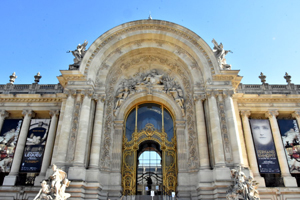 |
| Paris Municipal Petit Palais Museum |
| From February 21 to 26, 2019, the nephew of Urasenke Iemoto SEN Soshitsu XVI, IZUMI Reijiro (Vice Director, Urasenke Chado Research Center, Kyoto), was in Paris, France, to present a two-day program of lectures at the Petit Palais, as part of the "Japonismes 2018" celebration marking the 160th anniversary in 2018 of the Japan-France Treaty of Amity and Commerce. This chanoyu lecture program, which attracted approximately 220 participants, was among the special events putting the final touch on the "Japonismes 2018" celebration which had been held over a period of eight months in and around Paris to introduce the culture and arts of Japan. The first order of business for IZUMI Reijiro, for whom this was his first time abroad as Urasenke Chado emissary, was to pay a courtesy call on Japan's Ambassador to France, H.E. KITERA Masato, at the Japanese Embassy in Paris. Ambassador Kitera shared recollections of when he himself served as Japanese ambassador to China and was thus connected with the energetic work being done in that country by SEN Genshitsu, Reijiro's grandfather. His words of assurance about the French people's enthusiasm and power of understanding to connect to the culture and arts of Japan worked wonders in easing the anxiety that Reijiro was feeling about his given task over the next two days. |
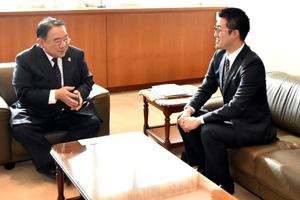 |
| The lecture program held at the Petit Palais from the next day, February 23 (Saturday), opened with a greeting from President SUGIURA Tsutomu of the Maison de la culture du Japon à Paris, which is the French office of the Japan Foundation. He and his staff had worked tirelessly in helping to organize and ensure the success of "Japonismes 2018," and it was through them that Urasenke was requested to present this lecture program. Reijiro's lecture on this first day, entitled "To Learn Chanoyu: The Entryway to Japanese Culture," focused on a general explanation of what a chaji (chanoyu function) involves, including the chashitsu architectural environment for it, as well as the spirit and ideals which are at the core of Japan's "way of tea" or so-called "tea ceremony." A short video showing the flow of a chaji was included. Taking care to speak in terms which his listeners who had little pre-knowledge of chanoyu could relate to, Reijiro drew his audience into the chaji experience. |
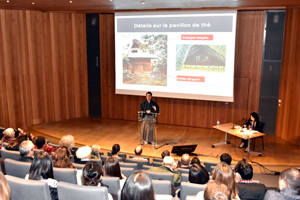 |
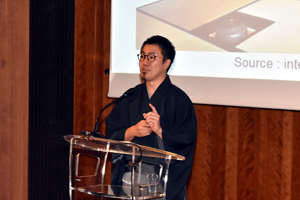 |
| The lecture program the next day, February 24 (Sunday), was entitled "Japan's Tea-drinking Culture." Like the program the previous day, it began with a greeting from President Sugiura. Reijiro’s lecture this time was from the perspective of Japan's chanoyu-related cultural and art history, focusing on the long period leading to the appearance of SEN Rikyu and the ultimate development, by SEN Rikyu, of the spirit and ideals which came to form the core of Japan's "way of tea." He had a very attentive audience, and when the lecture ended, was surrounded by those wishing to ask questions. |
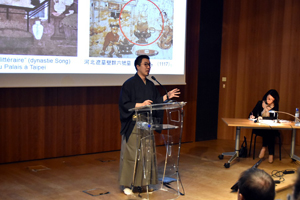 |
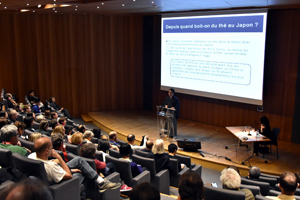 |
| Over the two days, the south pavilion at the Petit Palais Museum was arranged as a tea-service venue, where temae (the specific manner for preparing matcha in view of guests) was conducted using a set of furniture specially designed for this, and program participants, other visitors to the museum, and museum staff could sit and be served tea sweets and usucha (matcha of relatively thin consistency) while observing this and receiving explanations about it. Approximately 550 people came by for this. |
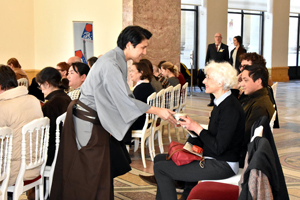 |
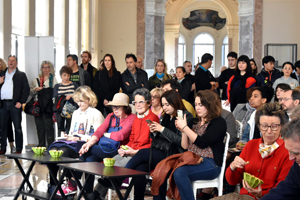 |
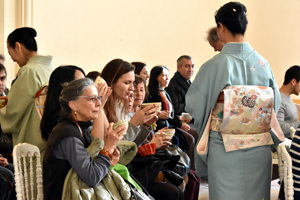 |
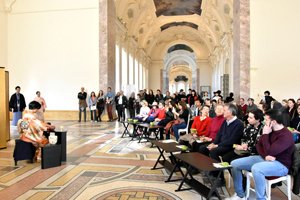 |
| HOME |